

Groovy 2.1 release notes. With this new 2.1 release, Groovy: has full support for the JDK 7 “invoke dynamic” instruction and API,goes beyond conventional static type checking capabilities with a special annotation for closure delegate based Domain-Specific Languages and static type checker extensions,provides additional compilation customization options,and features a meta-annotation facility for combining annotations elegantly.
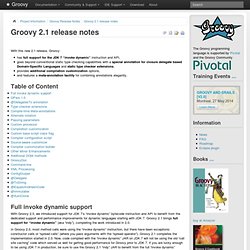
Full invoke dynamic support. Groovy 2.0 online webinar. Groovy: The roadmap for the popular JVM language. Groovy is a popular, open source, dynamic language residing on the Java Virtual Machine.
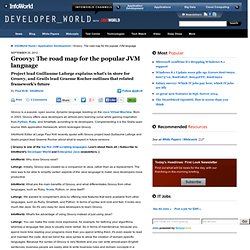
Born in 2003, Groovy offers Java developers an almost-zero learning curve while gaining inspiration from Python, Ruby, and Smalltalk, according to its developers. Complementing it is the Grails open source Web application framework, which leverages Groovy. What’s new in Groovy 2.0? The newly released Groovy 2.0 brings key static features to the language with static type checking and static compilation, adopts JDK 7 related improvements with Project Coin syntax enhancements and the support of the new "invoke dynamic" JVM instruction, and becomes more modular than before.
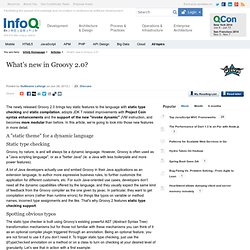
In this article, we’re going to look into those new features in more detail. A "static theme" for a dynamic language Static type checking. Release Notes - jira.codehaus.org. Bug [GROOVY-5463] - "Caught: BUG!

Edit/Copy Release Notes The text area below allows the project release notes to be edited and copied to another document. Release candidate of Groovy 2.0 available. This is with great pleasure that the development team announces the release candidate of Groovy 2.0.

The big change in this release candidate is the modularity aspect. We've now fully switched to Gradle, as our build tool, to build a more modular Groovy. You still have a big "all" JAR, but if you're interested in just picking the core JAR and the needed modules for your project, you can now do so. The following modules, also available as Maven artifacts, have been created and extracted: ant, bsf, console, docgenerator, groovydoc, groovysh, jms, json, jsr-223, servlet, sql, swing, templates, test, testng, xml.
Also, it's possible for you to create your own extension modules, which will provide additional methods to JDK or third-party classes, just like Groovy does with the Groovy Development Kit. For more information on this extension module system, please have a look at this page explaining the details. We're looking forward to your feedback on this release! Download. Groovy 1.8 is the latest maintenance release branch of the Groovy 1 major version.
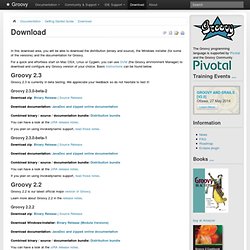
Groovy 1.8.9 Download zip: Binary Release | Source Release Download documentation: JavaDoc and zipped online documentation You can have a look at the JIRA release notes. For those who want to test the very latest versions of Groovy and live on the bleeding edge, you can use our snapshot builds. Groovy 1.8.5 and second beta of 2.0 out. Groovy 1.8.4 & 2.0-beta-1 released and roadmap updates. It is with great pleasure that we are announcing another joint release today!

We have released Groovy 1.8.4, that includes fixes and minor improvements to correct problems the Grails web framework and the Gradle build automation tool were having with 1.8.3. In addition, we are also pleased to announce the release of Groovy 2.0-beta-1! Groovy's updated version numbering scheme Yes, you heard it, a Groovy 2.0 beta! But what's going on, weren't we working on the 1.9 line? Historically, Groovy's "major" versions have always been "dot" versions, which is a bit uncommon in our industry, in the sense that major versions are expected to have a new major digit each time. Groovy. Customize Groovy Console Visual Output.
The Groovy Console ($ groovyConsole) is a great tool to run Groovy scripts and experiment with Groovy.

Normally when we run a script the return result (if not null) is shown as a string value. We can customize the way the value is shown by creating a new file with the name OutputTransforms.groovy in our GROOVY_HOME directory. Normally this directory is located in your user directory with the name .groovy. In OutputTransforms.groovy we must fill the internal script variable transforms of type ArrayList with a closure where we do the actual customization of the return result. The closure has one parameter which is the return result of the script. Groovy 1.8.3 and 1.9-beta-4 released. Those two releases are essentially about bug fixes and minor enhancements, but we also have interesting developments going on for static type checking your Groovy code, and for invoke dynamic support for performance of our dynamic core.
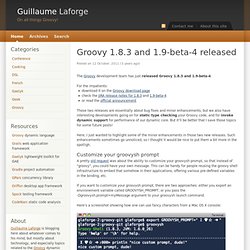
But it'll be better that I save those topics for some future posts! Here, I just wanted to highlight some of the minor enhancements in those two new releases. Such enhancements sometimes go unnoticed, so I thought it would be nice to put them a bit more in the spotligh. Customize your groovysh prompt A pretty old request was about the ability to customize your groovysh prompt, so that instead of "groovy", you could have your own message. If you want to customize your groovysh prompt, there are two approaches: either you export an environement variable called GROOVYSH_PROMPT, or you pass the -Dgroovysh.prompt=myMessage argument to your groovysh launch command.
Here's a screenshot showing how one can use fancy characters from a Mac OS X console: Groovy, JavaScript, Ruby Among Fastest Growing Programming Languages - Application Development. By Darryl K.
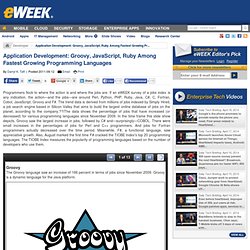
Taft | Posted 2011-09-12 Email Print. Groovy 1.8.2 and 1.9-beta-3 are in the wild. This is with great pleasure that the Groovy development team announces the joint releases of Groovy 1.8.2 and 1.9-beta-3. The big highlight of this release is the completion of the primitive type arithmetics performance optimizations. Microbenchmarks affictionados should be happy, and those wanting to do some number crunching should see better results with these improvements.
Other than that, those two releases are essentially about bug fixes. You can have a look at the release notes here: Groovy 1.8.1 update and first beta for Groovy 1.9. A rough guide to JVM languages. O’Reilly is celebrating the release of Java 7, and our inaugural OSCON Java conference: July 25-27 in Portland, Ore. The possibility of using alternative languages on the JVM has always been an appealing side story to Java. Jython and JRuby were early pioneers in implementing a dynamic language on top of a statically typed VM. Now that Java 7 directly includes support in the JVM for dynamic languages, the coexistence is official. Pick any of the languages here and you can expect the support of the robust JVM threading and garbage collection, plus access to a broad array of application libraries. Ten Groovy One Liners to Impress Your Friends. Language Comparison: Compute Factorial - Groovy, Java, and ColdFusion.
We Recommend These Resources A friend of mine is in school and taking some classes in Java, and also happens to be learning ColdFusion on the side. He was talking about the class and how they were learning about recursion and how they used the example of computing the factorial of a given number. Just for fun I took that opportunity to do this in a couple of languages... just to see what they look like side by side.
Please note there are no advantages or disadvantages to any of these code samples, but instead is shown as something educational... food for the brain if you will. :) **ColdFusion** Day 1. For the first time this year Gr8Conf organized a university day. On this day 3 hour sessions where given about Groovy (in the morning) and Grails (in the afternoon). In the morning I did the session about Getting Groovy together with Søren Berg Glasius (one of the organizers of Gr8Conf). We had a lot of topics to cover and didn't make it to cover it all during the session. Luckily we created a big document with all the topics and a lot of sample code (also from the Groovy Goodness blog series) for the attendees.
So hopefully people will look into the document to learn more about the topics we couldn't cover. Interviews: Peter Gromov on IntelliJ's Groovy support. Hello and welcome to another DZone interview. Without a doubt IntelliJ IDEA is the IDE of choice of many Groovy developers out there, simply because it was the first IDE to raise the bar in terms of support for the language -- and continues to do so. Peter Gromov is currently in charge of all things Groovy on IntelliJ, let's hear what he has to say about his experiences with the language. Enjoy! Andres Almiray: Could you please introduce yourself. CodeGeneration_gr8_2011. Making Your Life Simpler—How Groovy Can Leverage Your Existing Java Skill.
We Recommend These Resources Java is a large, powerful language, but it’s showing its age. Decisions made early in its development are not necessarily appropriate now, and over time it has accumulated problems and inconsistencies. Grails Podcast Episode 123: CloudFoundry & Groovy 1.8. Tuple Constructor Creation. Groovy 1.8 release notes. Table of Contents. Groovy Almanac. DCI in Groovy. DCI (Data Context Interaction) is a new way to look at object oriented programming. If you’d like to read some theory to see the difference between DCI and traditional OOP there is a nice article coverting the topic: Cogitations and Speculations: JDK 7: New Interfaces, Classes, Enums, and Methods. The following Groovy script provides a brute force mechanism for searching the online JDK 7 Javadoc API documentation for methods, classes, enums, methods, and interfaces that contain the string "1.7.
" I threw this together quickly and believe there are several more elegant ways to do this, but this was easy to write and does the job. The above Groovy script searches the Javadoc documentation for "1.7" and provides a list of Javadoc files for classes, enums, interfaces, and methods that include the "1.7" string. According to the script's output, 4020 files were searched and 304 of those files contained at least once occurrence of the "1.7" string. The following Javadoc HTML files were identified by the script as containing the string "1.7" somewhere within the page's documentation. Release Notes - groovy - Version 1.7.10 - HTML format. Release Notes - groovy - Version 1.7.9 - HTML format. First release candidate of Groovy 1.8. Download Grails. Victor Savkin's Blog - Groovy Coding Style. I’ve been using Groovy for about 4 years. The code that I used to write 3 years ago looks very different from the 1 year old code and from the code I am writing these days.
Groovy++ in action: how to make $5000 in one hour. Groovy 1.7.7 and 1.8-beta-4 released. Rich Internet Applications (RIA) » Blog Archive » Effective Groovy with CodeNarc 0.12. Cedric Champeau's Weblog. Dustin's Software Development Cogitations and Speculations: Groovy. Cedric Champeau's Weblog. Tutorial: Build Twitter with Groovy Grails in 90 Minutes. Paul King on the Groovy Ecosystem. Talking Groovy, Programming Languages, and Code Quality with Hamlet D'Arcy. Groovy - user - Groovy 1.7.6 and 1.8-beta-3.
Xappworks. Aspen Biosciences Blog. Welcome! Groovy for Business Software. Why not? Groovy web console - Einstein's riddle using Choco 2. PLEAC-Groovy. Download. Home. The search is over. GroovyMag - the magazine for Groovy and Grails developers about. Framework Reference Documentation. Tutorials. Documentation. Documentation. Griffon - Home. Griffon - Documentation. Everything for the Groovy & Grails developer. Griffon Guide 0.3.1 Reference Documentation. Recent Entries (Last 7 Days) Messages from mrhaki.